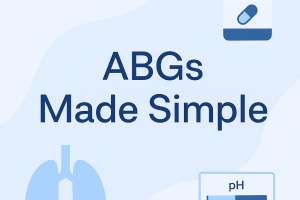Understanding ABG Interpretation for the NCLEX: A Beginner’s Guide

Arterial Blood Gas (ABG) interpretation is one of the most intimidating—but essential—topics tested on the NCLEX. Whether you love or dread lab values, ABG questions test your ability to assess a patient’s oxygenation, acid-base balance, and ventilation status.
This guide breaks down ABGs into simple, clear steps you can follow—every time.
What Is an ABG?
An ABG test measures:
- pH – acid or base level in the blood
- PaCO₂ – partial pressure of carbon dioxide (respiratory)
- HCO₃ – bicarbonate (metabolic)
- PaO₂ & SaO₂ – oxygen levels in the blood
These values tell you whether a patient is acidotic or alkalotic and whether the root cause is respiratory or metabolic.
Normal ABG Values You MUST Know
| Component | Normal Range |
|---|---|
| pH | 7.35 – 7.45 |
| PaCO₂ | 35 – 45 mm Hg |
| HCO₃ | 22 – 26 mEq/L |
| PaO₂ | 80 – 100 mm Hg |
| SaO₂ | 95 – 100% |
Memorizing these is step one in mastering ABGs.
Step-by-Step ABG Interpretation
Step 1: Look at pH
- pH < 7.35 = Acidosis
- pH > 7.45 = Alkalosis
Step 2: Determine Respiratory or Metabolic
- PaCO₂ abnormal? → respiratory issue
- HCO₃ abnormal? → metabolic issue
Step 3: Match the pH
- If the pH matches the direction of PaCO₂ → Respiratory
- If it matches HCO₃ → Metabolic
Step 4: Check for Compensation
- Uncompensated: pH is abnormal, and only one value is off.
- Partially compensated: all three values are off.
- Fully compensated: pH is normal, but PaCO₂ and HCO₃ are both abnormal.
Common ABG Scenarios on NCLEX
1. Respiratory Acidosis
- Cause: Hypoventilation (e.g., COPD, drug overdose)
- ABG: ↓pH, ↑PaCO₂, normal HCO₃
- Symptoms: Confusion, headache, drowsiness
2. Respiratory Alkalosis
- Cause: Hyperventilation (e.g., anxiety, fever)
- ABG: ↑pH, ↓PaCO₂, normal HCO₃
- Symptoms: Lightheadedness, numbness, tingling
3. Metabolic Acidosis
- Cause: DKA, renal failure, diarrhea
- ABG: ↓pH, normal PaCO₂, ↓HCO₃
- Symptoms: Kussmaul respirations, nausea, fatigue
4. Metabolic Alkalosis
- Cause: Vomiting, diuretics, antacids
- ABG: ↑pH, normal PaCO₂, ↑HCO₃
- Symptoms: Muscle cramps, confusion, slow respirations
NCLEX Tips for ABG Questions
- Always analyze values one at a time—don’t rush.
- Choose answers that address the underlying cause, not just symptoms.
- Look out for compensation clues—especially in chronic conditions like COPD.
Final Thoughts
ABG interpretation doesn’t have to be overwhelming. When you memorize the normal values, follow a logical step-by-step approach, and understand common causes and compensation, you’ll be ready to ace ABG questions on the NCLEX.
Keep practicing with sample questions—and remember: clarity and calm analysis will always lead you to the right answer.






